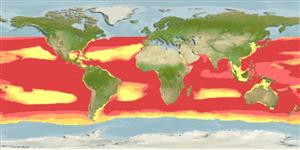Common names from other countries
>
Stomiiformes (Lightfishes and dragonfishes) >
Sternoptychidae (Marine hatchetfishes) > Sternoptychinae
Etymology: Argyropelecus: Greek, argyros = silvered, silver + Greek, pelekys = axe (Ref. 45335).
More on author: Regan.
Environment: milieu / climate zone / depth range / distribution range
Ecologia
marino batipelagico; distribuzione batimetrica 0 - 2926 m (Ref. 26165). Deep-water; 46°N -
Atlantic, Indian and Pacific: in tropical waters. Eastern Atlantic: Cape Blanc, Mauritania to Namibia. Eastern Pacific: Oregon to southern California in the USA (Ref. 265). Southeast Pacific: Chile (Ref. 9068). South China Sea (Ref.74511).
Size / Peso / Age
Maturity: Lm ? range ? - ? cm
Max length : 8.3 cm TL maschio/sesso non determinato; (Ref. 126117); peso massimo pubblicato: 13.20 g (Ref. 126117)
Short description
Chiavi di identificazione | Morfologia | Morfometria
Spine dorsali (totale) : 0; Raggi dorsali molli (totale) : 9; Spine anali: 0; Raggi anali molli: 11 - 12; Vertebre: 35 - 38. Branchiostegal rays: 10 (Ref. 35838).
Mesopelagic (Ref. 58302). Found in 50-600 m during the day and 100-375 m at night (Ref. 4054). Feed on copepods (Ref. 6885). Oviparous, with planktonic eggs and larvae (Ref. 35838).
Life cycle and mating behavior
Maturities | Riproduzione | Spawnings | Egg(s) | Fecundities | Larve
Quéro, J.-C., J.C. Njock and M.M. de la Hoz, 1990. Sternoptychidae. p. 275-282. In J.C. Quero, J.C. Hureau, C. Karrer, A. Post and L. Saldanha (eds.) Check-list of the fishes of the eastern tropical Atlantic (CLOFETA). JNICT, Lisbon; SEI, Paris; and UNESCO, Paris. Vol. 1. (Ref. 4462)
IUCN Red List Status (Ref. 130435)
CITES (Ref. 128078)
Not Evaluated
Threat to humans
Harmless
Human uses
Pesca: di nessun interesse
Strumenti
Special reports
Download XML
Fonti Internet
Estimates based on models
Preferred temperature (Ref.
115969): 3.7 - 11.6, mean 6.2 (based on 2263 cells).
Phylogenetic diversity index (Ref.
82804): PD
50 = 0.5078 [Uniqueness, from 0.5 = low to 2.0 = high].
Bayesian length-weight: a=0.02239 (0.01320 - 0.03796), b=2.95 (2.80 - 3.10), in cm Total Length, based on LWR estimates for this species & Genus-body shape (Ref.
93245).
Trophic level (Ref.
69278): 3.1 ±0.16 se; based on food items.
Resilienza (Ref.
120179): Medio, tempo minimo di raddoppiamento della popolazione 1.4 - 4.4 anni (Assuming tmax>3).
Fishing Vulnerability (Ref.
59153): Low vulnerability (10 of 100).
